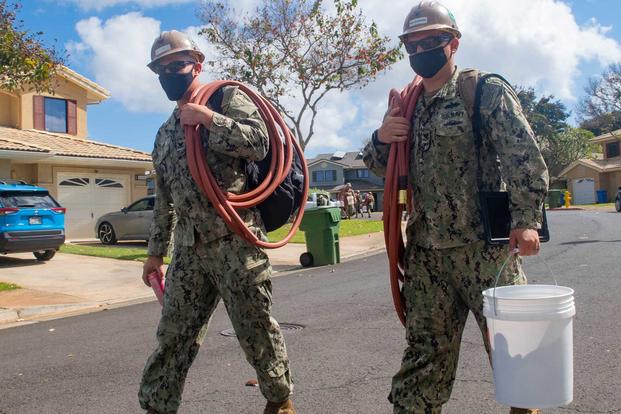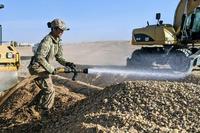The Navy announced Saturday it completed initial flushing and testing of the water distribution lines at Joint Base Pearl Harbor-Hickam in Hawaii.
Positive test results from the system-wide flush could allow the service to begin flushing affected homes and buildings, paving the way for residents to return to their houses or begin using water from their taps.
While the Navy is making progress on clearing out tainted water, the federal government and Hawaii Department of Health are seeking input from residents of military housing near base to better understand the health effects of a fuel spill that resulted in thousands being exposed to petroleum in their drinking water.
Read Next: Head of Special Operations Command Tests Positive for COVID-19
The survey is being conducted by the state, the Centers for Disease Control and Prevention, the National Center for Environmental Health and the Agency for Toxic Substances and Disease Registry.
In an email sent to Military.com last week, a CDC official said the survey, which will be open until Feb. 7, "will be used to better understand the health impacts of this contamination event and determine what steps are needed to protect public health."
The survey asks questions about symptoms, medical care, information sharing and logistical support throughout the crisis.
Meanwhile, the Interagency Drinking Water System Team announced Saturday it has completed initial flushing of the water distribution system for 19 neighborhood zones and is awaiting results of third-party testing before launching the next phase of its cleanup plan.
If test results confirm that the system water is safe to drink in the affected areas, the service will begin flushing homes and buildings, according to a press release from the Navy's Joint Information Center.
But if the results indicate that contaminants remain in the water, more system flushing will be done, according to Navy officials.
Thousands of military personnel and family members using the Navy's water system in Honolulu began reporting in late November that the water from their taps smelled like fuel or chemicals.
They also reported health symptoms that included vomiting, nausea, diarrhea, headaches and unexplained rashes -- some with symptoms so severe they sought medical care.
Hawaii Department of Health officials and the Navy later confirmed that a system well was contaminated with JP-5, or jet fuel, likely related to a spill earlier in the month at the service's Red Hill Bulk Fuel Storage Facility.
Many families were displaced, with their services providing them temporary allowances, while others have opted to remain in their homes and use water supplied from other sources, including water tanks and shower stations. The Navy began flushing the distribution lines on Dec. 20.
The service tested its flushing protocol beginning with the neighborhood of Pearl City Peninsula and on Sunday released test results for the neighborhood that showed the levels for all potential contaminants, including petroleum products, chemicals and heavy metals were not detectable or at levels significantly below the screening threshold established by the state.
The service now predicts that families in Pearl City will be able to return to their homes on Jan. 28 if the flushing of their homes goes as planned.
But most residents will have to wait until February, under an update published by the Navy last week. The schedule had been delayed as a result of heavy rains in Hawaii over New Year's Day weekend.
Move-in dates for nearly 3,000 homes have yet to be scheduled, with the service still developing their flushing plans, including Aliamanu Military Reservation, Iroquois Point and Red Hill.
The Interagency Drinking Water System Team, consisting of the Navy, Army, Hawaii Department of Health and the Environmental Protection Agency, said the flushing and testing process of the entire system, from distribution to residential taps, should take 37 to 44 days, if all goes as planned.
On the Joint Base Pearl Harbor-Hickam Facebook page, residents said teams have been visiting their homes to flush them and complained that when they asked for the system results before they allowed their homes to be flushed, they were rebuffed.
In a post on LinkedIn on Sunday, Vice Adm. Yancy Lindsey, Navy Installations commander, praised the response team, but also noted additional obstacles that include "multiple agendas and narratives; and a difficult media/social media environment make achieving a successful outcome about much more than science and water."
Following complaints about the smell of the water, Navy officials initially said they tested their wells and found no evidence of contamination. Hundreds contacted military family advocates to complain about the pollution, and the state of Hawaii later detected a petroleum product had contaminated the water system.
The service later apologized for officials' initial reaction, with Secretary of the Navy Carlos Del Toro and Chief of Naval Operations Adm. Michael Gilday saying the service "stumbled" in communicating with families, adding they would be more transparent and build a "water system that they can completely trust."
"I deeply apologize to each and every one of you and to the people of Hawaii that this incident may have been destructive to your lives in any way," Del Toro told families during a town hall in December.
-- Staff writer Konstantin Toropin contributed to the report. He can be reached at Konstantin.Toropin@Military.com.
-- Patricia Kime can be reached at Patricia.Kime@Military.com. Follow her on Twitter @patriciakime
Related: DoD Put Troops and Families at Risk with Slow Response to 'Forever Chemicals,' Report Finds













